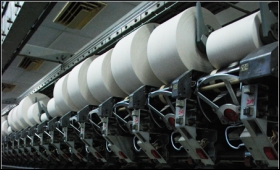|

|
NITMA reduces yarn prices to help textile sector
|
|

|
|
| Top Stories |
 |
|
|
|
SME Times News Bureau | 28 Apr, 2010
In a bid to help the clothing and other downstream segments of the textile industry, which have been in a bind over soaring cotton prices, the member mills of Northern India Textile Mills Association (NITMA) have agreed to reduce cotton yarn prices by Rs.5 per kg with effect from 1st May 2010, said NITMA President, Ashish Bagrodia on Tuesday.
"Such a reduction will help us to build a collaborative approach on the part of all the segments of our textile and clothing industry," said Bagrodia in a press release stating that the NITMA member mills have agreed to reduce the cotton yarn prices to extend support to the downstream sectors.
The members of NITMA have also agreed to extend their fullest support to the handloom sector by supplying adequate quantity of hank yarn and to ensure availability of cotton yarn to the other domestic user industry, Bagrodia added.
The NITMA President appealed to the Union Textile Minister to drop the proposal of withdrawing the duty drawback for cotton yarn.
"The Indian spinning sector could achieve a 15 percent share in the global yarn trade owing to the concerted efforts made over decades. Any further negative steps against this sector like removal of duty drawback or levying export duty on cotton yarn or any other control on cotton yarn exports would become counter productive," Bagrodia cautioned.
He said that the government had already withdrawn the DEPB (Duty Entitlement Pass Book) benefit of 7.67 percent and the removal of drawback would make the Indian yarn very expensive in the international market and the spinning industry would lose their customers who have been nurtured in the last 20 years after liberalization.
The competing countries like China, Pakistan, Thailand, Indonesia, Bangladesh etc., would grab the opportunities, the NITMA chief added.
Since October, the textile industry had been demanding for government measures to regulate sale of raw cotton. As the economic recovery set in, the demand for cotton, both domestically and globally, saw a significant increase, which led to a consistent surge in raw material costs.
The government clamped a ban on cotton exports from April 19 to ensure adequate availability of raw cotton for the domestic industry.
|
|
|
| |
|
|
|
|
|
|
|
|
|
|
|
|
|
|
| |
| Customs Exchange Rates |
| Currency |
Import |
Export |
US Dollar
|
84.35
|
82.60 |
UK Pound
|
106.35
|
102.90 |
Euro
|
92.50
|
89.35 |
| Japanese
Yen |
55.05 |
53.40 |
| As on 12 Oct, 2024 |
|
|
| Daily Poll |
 |
 |
| Do you think Indian businesses will be negatively affected by Trump's America First Policy? |
|
|
|
|
|
| Commented Stories |
 |
|
|
|
|
|
| |
|